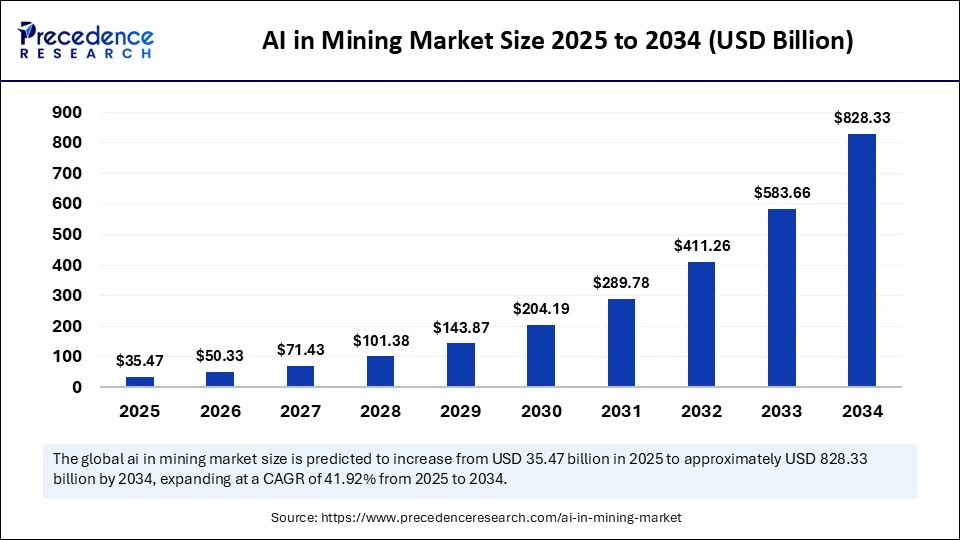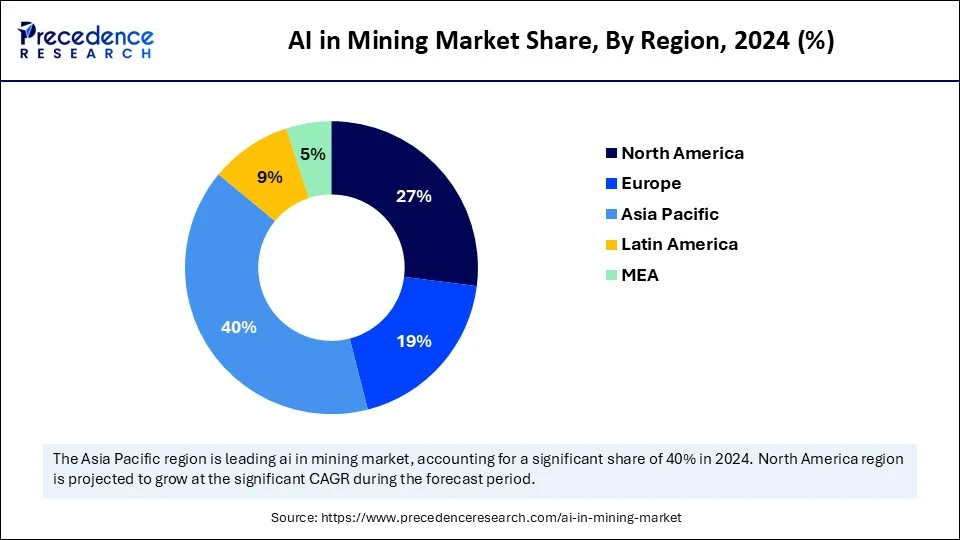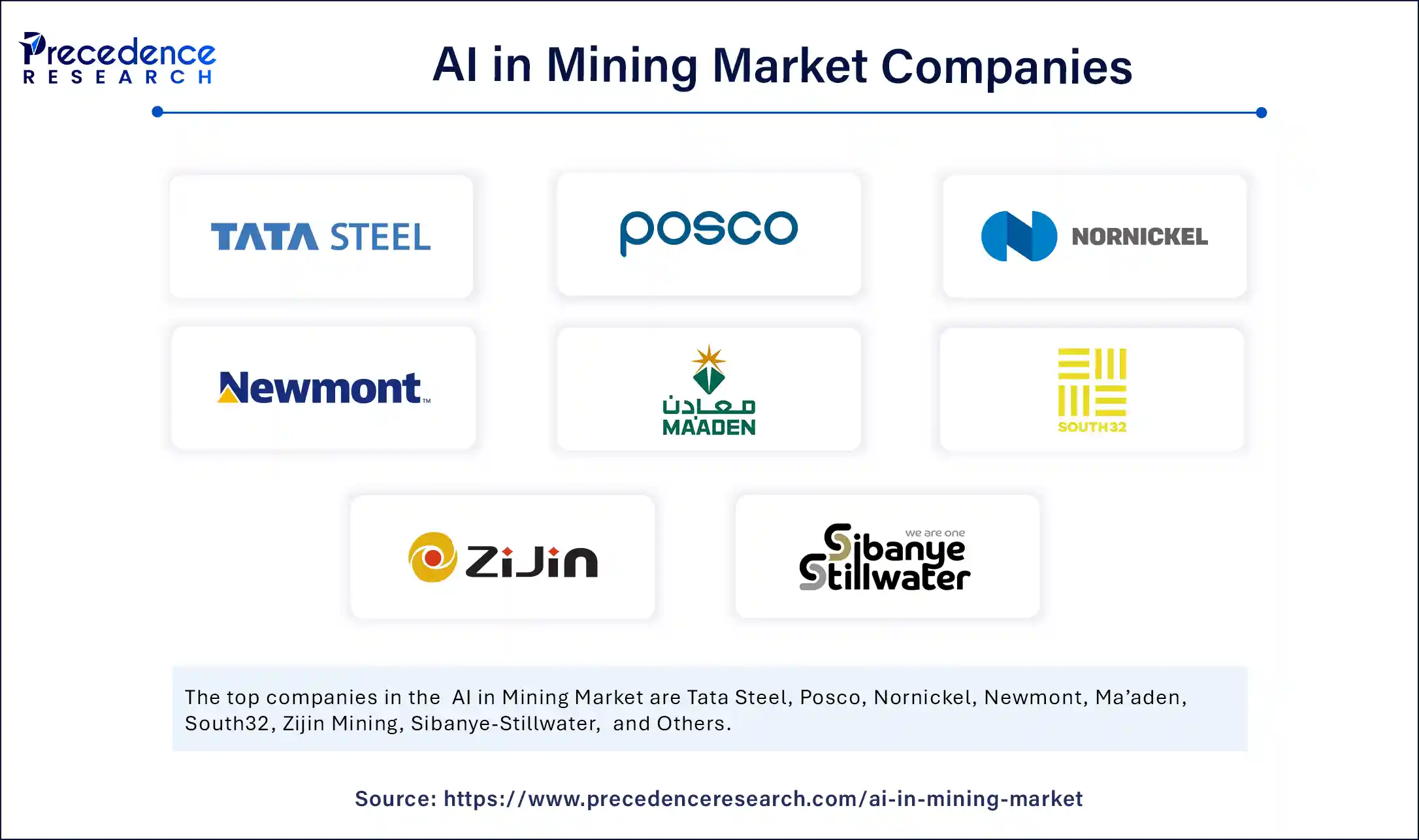AI in Mining Market Set for Transformative Growth as Automation and Predictive Analytics Reshape the Industry
According to Precedence Research, the global AI in mining market size was valued at USD 24.99 billion in 2024 and is projected to rise from USD 35.47 billion in 2025 to nearly USD 828.33 billion by 2034, growing at an impressive CAGR of 41.92% between 2025 and 2034. This rapid expansion is fueled by advancements in AI and machine learning models that enhance safe mining operations, strong government-backed mining initiatives, and the transformative benefits that artificial intelligence brings to the mining industry.

The global AI in mining market is poised for remarkable expansion, driven by the growing adoption of automation, predictive maintenance, and data-driven decision-making in the mining sector. Artificial Intelligence (AI) is transforming how mining companies manage operations, optimize production, and address sustainability challenges.
The mining industry—traditionally labor-intensive—is now witnessing a paradigm shift with AI applications ranging from real-time ore body modeling to autonomous hauling systems and predictive equipment monitoring. This digital transformation is creating new opportunities for efficiency, safety, and profitability across both developed and emerging markets.
Market Insights & Forecast
The AI in mining market is expected to grow significantly through 2034, supported by rising demand for automation in mineral exploration and extraction. A key factor driving growth is the industry’s increasing reliance on predictive analytics to reduce downtime and enhance asset utilization. Mining companies are investing heavily in AI-driven solutions to address challenges such as workforce safety, cost control, and environmental sustainability. From autonomous trucks that reduce accident risk to AI algorithms that optimize drilling patterns, artificial intelligence is evolving from a support tool to a core strategic enabler in mining.
AI in Mining Market Key Highlights:
- In terms of revenue, the global AI in mining market was valued at USD 24.99 billion in 2024.
- It is projected to reach USD 828.33 billion by 2034.
- The market is expected to grow at a CAGR of 41.92 % from 2025 to 2034.
- Asia Pacific dominated the AI in mining market with the largest market share of 40% in 2024.
- North America is expected to witness the fastest growth during the forecast period.
- By technology, the machine learning segment held the biggest market share of 30% in 2024.
- By technology, the deep learning segment is expected to grow at the fastest CAGR during the forecast period.
- By application, the exploration segment captured the highest market share of 25% in 2024.
- By application, the predictive maintenance segment is expected to witness the fastest growth during the projection period.
- By end use industry, the metal mining segment contributed the biggest market share of 40% in 2024.
- By end use industry, the non-metallic mining segment is expected to grow at the highest CAGR between 2025 and 2034.
- By solution type, the software segment generated the major market share of 50% in 2024 and is expected to witness the fastest growth during the forecasted years.
- By deployment mode, the cloud-based segment accounted for the largest market share of 70% in 2024.
- By deployment mode, the on-premises segment is expected to register the fastest CAGR during the forecasted years of 2025-2034.
- By mining type, the surface mining segment held the major market share of 55% in 2024.
- By mining type, the underground mining segment is expected to witness the fastest CAGR during the forecasted years.
💡 Expert Analysis
Commenting on the report findings, a Precedence Research spokesperson stated:
“AI is not just modernizing the mining industry—it is redefining its future. From reducing carbon footprints to enabling safer and smarter mining, AI solutions are creating measurable value across the mining value chain. Companies investing in AI today will be better positioned to address global demand, sustainability challenges, and competitive pressures in the decade ahead.”
Key Trends Shaping the AI in Mining Market
1. Smarter Mineral Exploration with Machine Learning
One of the most transformative trends in the AI in mining market is the use of machine learning (ML) models for mineral exploration. These advanced algorithms combine geospatial data, satellite imagery, and historical mining records to identify untapped mineral deposits with far greater accuracy than conventional methods. By reducing exploration costs and improving precision, ML is helping mining companies unlock new opportunities for critical resources such as rare earth elements. Leading innovators, including KoBold Metals, are already using AI-driven exploration to discover essential materials that power next-generation technologies like electric vehicles and renewable energy systems.
2. Rising Adoption of Digital Twin Technology
Another key trend is the increasing application of digital twin technology, which creates a virtual replica of mining sites, machinery, and processes. These real-time simulations enable companies to model operational scenarios, assess risks, and optimize strategies before actual mining begins. By reducing uncertainty and improving planning, digital twins not only boost productivity but also support safer and more sustainable mining practices. This technology is rapidly becoming a strategic tool for companies looking to minimize downtime and maximize resource efficiency.
3. AI-Powered Supply Chain Optimization
Artificial intelligence is also redefining supply chain management in mining, ensuring greater efficiency and transparency. Through predictive analytics, companies can forecast demand, optimize logistics, and manage inventories with higher accuracy. AI also plays a critical role in mineral traceability, enabling firms to monitor sourcing practices and meet global standards for ethical and sustainable mining. By lowering costs and strengthening reliability, AI-driven supply chain solutions are setting new benchmarks for operational excellence in the mining industry.
View Full Report @ https://www.precedenceresearch.com/ai-in-mining-market
AI in Mining Market Segmentation Analysis
Technology Analysis
In 2024, machine learning (ML) emerged as the dominant technology in the AI in mining market, capturing the largest share of around 30%. This leadership is largely driven by the ability of ML models to enhance safety, boost productivity, and streamline mining operations through real-time monitoring and process optimization. Machine learning not only improves resource extraction efficiency but also accelerates mineral discovery by analyzing geological and molecular structures to identify patterns and potential deposits. As mining companies push for smarter and safer exploration techniques, ML has become the foundation for innovation across the sector.
Looking ahead, the deep learning segment is expected to grow at the fastest pace during the forecast period. Deep learning models are uniquely suited to handle complex datasets, providing valuable insights into underground water reservoirs, mineral types, and geological constraints. Their application in predictive maintenance is also fueling growth, as these models can accurately forecast equipment failures and schedule proactive repairs, significantly reducing downtime and operational costs.
Application Analysis
On the application side, the exploration segment led the market with a 25% share in 2024, reaffirming its importance as a cornerstone of mining. Exploration remains critical as companies strive to discover new minerals and rare earth elements needed for advanced technologies. AI has revolutionized this process by integrating predictive models, drones, and 3D mapping to reduce costs and improve accuracy, while ensuring safer operations in remote or challenging terrains. This has made exploration not only more efficient but also less resource-intensive.
Meanwhile, predictive maintenance is emerging as the fastest-growing application. The adoption of AI-driven predictive tools allows mining firms to shift from reactive maintenance to a proactive approach. By detecting anomalies and predicting future equipment failures through real-time data analysis, companies can optimize maintenance schedules, cut costs, and extend asset lifespans—ultimately ensuring more reliable and uninterrupted operations.
End-Use Industry Analysis
Within the mining industry, metal mining dominated the AI in mining market in 2024, holding a 40% share. This dominance stems from the surging demand for metals such as copper, iron, and rare earths, which are essential for industries ranging from construction and automotive to renewable energy. AI solutions are being widely applied in metal mining to identify drilling sites, improve extraction efficiency, and minimize waste. By processing vast geological datasets, AI models help pinpoint precise metal deposit locations while also monitoring safety conditions and predicting risks associated with deep drilling and ore extraction.
In contrast, the non-metallic mining segment is projected to record the fastest growth in the coming years. The demand for materials like limestone, potash, sand, and gravel continues to rise, and AI is playing a crucial role in automating their sorting, processing, and transportation. With automated haulage systems and AI-powered safety monitoring, non-metallic mining is becoming more efficient and less labor-intensive, particularly in hazardous environments.
Solution Type Analysis
From a solution perspective, AI-based software dominated the market in 2024, accounting for 50% of total share. This stronghold is a result of software’s ability to independently manage and optimize critical mining processes—from exploration and extraction to material processing. AI software enables mining companies to operate at scale while minimizing human intervention, thereby boosting accuracy, reducing downtime, and improving productivity. Furthermore, these platforms are increasingly helping companies align with environmental regulations and sustainability goals, offering advanced portfolio management and compliance tools that ensure responsible mining practices.
Deployment Mode Analysis
By deployment mode, the cloud-based segment took the lead in 2024 with a commanding 70% share. The appeal of cloud solutions lies in their flexibility, scalability, and cost-effectiveness. Mining companies benefit from centralized data storage, which makes AI model training more efficient by consolidating vast datasets in one platform.

Cloud deployment also enables real-time collaboration, seamless remote accessibility, and reduced need for on-site manpower—an essential advantage for operations spread across large geographic areas. As a result, cloud-based AI solutions are expected to remain the preferred choice for mining firms seeking both operational efficiency and long-term scalability.
Also Read@ Artificial Intelligence in Chemicals Market to Surpass USD 28 Billion by 2034 as Digital Twins and Sustainability Drive Transformation
AI in Mining Market Key Regional Analysis:
How Big is the Asia Pacific AI in Mining Market?
According to Precedence Research, the Asia Pacific AI in mining market is projected at USD 14.19 billion in 2025 and is forecast to reach approximately USD 335.47 billion by 2034, registering a strong CAGR of 42.09% during the period.

Asia Pacific dominated the global market in 2024, holding nearly 40% share, and is expected to maintain its lead over the forecast horizon. The region’s dominance can be attributed to its vast mineral reserves, large-scale mining operations, and aggressive adoption of advanced technologies such as artificial intelligence and machine learning. Governments across the region are supporting digital transformation in mining to improve efficiency, reduce costs, and enhance worker safety. These initiatives, combined with rapid industrialization and demand for critical raw materials, are reinforcing the market’s strong trajectory.
The region is also a global leader in mineral production, with high outputs of iron ore, copper, coal, and rare earth elements, which are crucial for semiconductor technologies, electric vehicle batteries, and renewable energy systems. China remains the largest contributor, spearheading end-to-end automation projects and advanced AI-driven mining operations. The country accounts for more than 50% of global production in 18 different minerals and holds reserves of over 35 minerals, each with at least a 10% global concentration. India, meanwhile, is steadily modernizing its mining sector by deploying AI-powered solutions to improve safety, cut operational costs, and strengthen its position as a global mining hub.
For instance, in March 2025, India’s Ministry of Mines is set to launch the country’s first-ever auction of exploration licenses in Goa, unlocking new deep-seated mineral resources. Such initiatives are expected to accelerate AI adoption and expand the country’s role in the regional and global mining industry.

North America AI in Mining Market Outlook
While Asia Pacific holds the largest share, North America is expected to register the fastest growth during the forecast period. The region’s mining sector benefits from strong digital infrastructure and a culture of early adoption of cutting-edge technologies. Mining companies in the U.S. and Canada are at the forefront of AI-driven transformation, leveraging autonomous equipment, predictive analytics, and advanced monitoring systems to optimize operations.
The United States is a significant contributor, producing nearly 50% of seven key minerals and holding reserves of more than 10% in 12 different minerals. The push for advanced, tech-enabled mining practices is helping North America strengthen its competitive edge in AI deployment. With increasing demand for minerals to support clean energy transitions, the region is expected to remain a key growth driver for the global AI in mining market.
AI in Mining Market Leading Companies

- Tata Steel
- Posco
- Nornickel
- Newmont
- Ma’aden
- South32
- Zijin Mining
- Sibanye-Stillwater
Recent Developments:
- In June 2025, to revolutionize mining industry, artificial intelligence/ machine learning models are going to be used first time for mineral exploration in Rajasthan, India. (Source: https://www.thenewsminute.com)
- In May 2025, BHP is going to develop its first Industry AI hub in Singapore, aiming to accelerate digital revolution and AI adoption in the mining and resources field. (Source: https://www.bhp.com)
Segments Covered in the Report
By Technology
- Machine Learning
- Deep Learning
- Natural Language Processing
- Computer Vision
- Robotics & Automation
- Data Analytics
- IoT (Internet of Things)
By Application
- Exploration
- Geological Data Analysis
- Exploration Planning
- Mineral Discovery
- Extraction
- Automated Drilling
- Blasting Optimization
- Remote Mining Equipment Control
- Processing
- Ore Sorting
- Process Optimization
- Smelting and Refining Automation
- Predictive Maintenance
- Equipment Health Monitoring
- Predictive Analytics for Downtime
- Safety and Security
- Hazard Detection
- Autonomous Vehicles for Mining
- Surveillance Systems
- Environment and Sustainability
- Environmental Impact Monitoring
- Waste Management
- Supply Chain and Logistics
- Supply Chain Optimization
- Demand Forecasting
- Transportation Automation
By End-Use Industry
- Metal Mining
- Copper
- Gold
- Silver
- Aluminum
- Zinc
- Nickel
- Coal Mining
- Non-Metallic Mining
- Oil Sands Mining
- Other Mineral Mining (e.g., Lithium, Rare Earths)
By Solution Type
- Software
- AI Platforms
- Data Management Tools
- AI-Driven Analytics Software
- Hardware
- Robotics and Drones
- Sensors and Actuators
- Autonomous Mining Vehicles
- Services
- AI Consulting
- System Integration
- Support and Maintenance
By Deployment Mode
- Cloud-Based
- On-Premises
By Mining Type
- Surface Mining
- Underground Mining
- Mountaintop Removal Mining
- Placer Mining
By Region
- North America
- Europe
- Asia Pacific
- Middle East & Africa
- Latin America
For inquiries regarding discounts, bulk purchases, or customization requests, please contact us at sales@precedenceresearch.com

